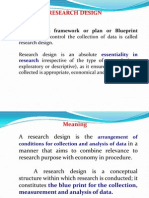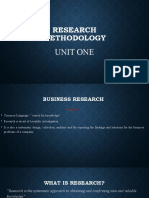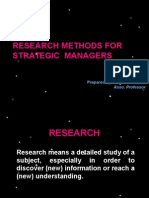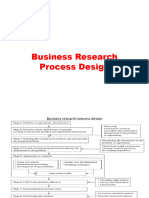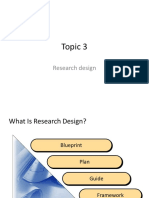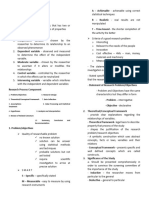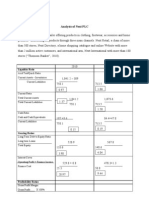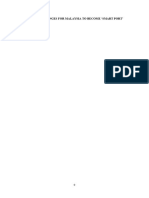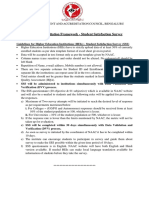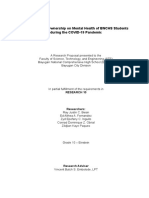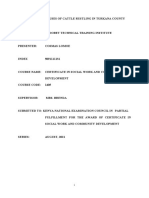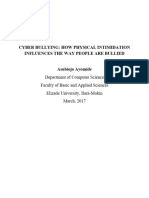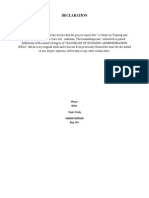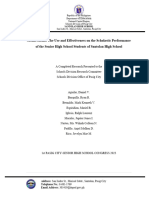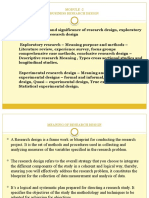www.atmc.edu.
au
� Business Research Methods
• Lecture 12: Revision
www.atmc.edu.au
� Learning Objectives
By the end of this lecture, the student should be able to:
• Understand what business research is.
• Understand Business Ethics, the role of sponsor and rights of respondent.
• Understand the steps to clear research design.
• Understand literature search need.
• Understand difference between quantitative and qualitative research.
• Sampling and how does it affect research design.
• What are the different modes of qualitative research.
www.atmc.edu.au
� What Is Good Research?
• The purpose of the business research should be clearly defined as unambiguously as
possible.
• Research that generates dependable data which can be used reliably for decision
making.
• Good research follows systematic, empirically based procedures for generating
replicable research.
• Language should be restrained, clear, and precise; assertions should be carefully
drawn and effort should be taken to achieve maximum objectivity.
• High ethical standards should be applied and research design should include
safeguards against causing harm to participants with data integrity a high priority
www.atmc.edu.au
� Research Process
Discover
Explore
Define Research Refine Research Finalize Research
Management
Question Question Proposal
Dilemma
Sampling Design
Execute
Field Work Instrument Quantitative
Qualitative
development
Data Collection
Design
Decide
Data Analysis and Research Reporting
Management Decision
Interpretation and Recommendation
www.atmc.edu.au
� Ethical Treatment of Participants
• Research should be designed to ensure the participant is safe both from physical
harm and emotional embarrassment or the invasion of privacy .
• Respondents should be put at ease by leading with an introduction from the
interviewer and the research organization. Then followed by the purpose and benefits
of the research.
• Obtaining informed consent from the participant is done by fully disclosing the
procedures of the proposed survey before requesting the permission to proceed.
• Participants should be informed that the purpose of study will be fully explained once
the survey is completed and at that time respondents may request to withdraw their
information from the survey.
www.atmc.edu.au
� Rights to privacy
• Guaranteed privacy is important as it not only helps to retain validity of the research,
but also protects the studied participants.
• A relevant example is telephonic survey of television viewers about movie viewing
habits, where the viewers were willing to disclose their movie preferences but
refused to cooperate when asked about porn viewing.
• Guaranteed confidentiality should ensure that only researchers who have signed the
non-disclosure agreements have access to the individual users’ data.
• Individuals have the right to private behaviour during the privacy in their homes or
private places, and should not be breached.
www.atmc.edu.au
� Designing the Research Project
• Selecting a research design may be complicated by the availability of a large variety
of methods, techniques, procedures, protocols, and sampling plans.
• Creative research design using diverse methodologies helps to achieve greater
insight than if the most frequently used method is blindly followed.
• Effective sampling design helps in ensuring results that can be projected amongst the
population and also make sure that results are statistically reliable.
• After sample design, pilot test is conducted to detect weaknesses in design and
instrumentation and to provide proxy data for selection of a probability sample.
www.atmc.edu.au
� Data Analysis and Interpretation
• Data analysis converts data into manageable chunks and then data is run through
analytical routines using variety of software tools.
• Analysis involves looking for data summaries, patterns, and applying statistical
techniques.
• Scaled responses on questionnaires can be used to gauge respondent’s degree of
acceptance or denial of specific attribute.
• Analysis also explores relationships among variables.
• Researchers must interpret these findings in light of the client’s research question
and further determine if the results are consistent with their hypotheses and
theories.
• Trends or deviations may be cross checked with historical data.
www.atmc.edu.au
� Literature Search
• By being familiarized with existing research and theory in an area, research project
can be revised to explore some of these newly identified questions.
• Reviewing the literature helps in design phase of the research as published research
provides a rich resource for addressing these important design questions.
• Reviewing the literature also keeps updated on current empirical or theoretical
controversies in a particular research area.
• Such controversies provide a rich source of research ideas and also give direction to
specific research hypotheses.
www.atmc.edu.au
� The purpose and types of critical review
• Literature may be used for identifying theories and ideas that will be tested with
data – in a deductive approach method.
• In other cases exploring data and on that bases building up theories is called
inductive approach.
• Inductive approach requires expertise and thorough knowledge of the literature in
one’s area.
• Literature review will review the most relevant and significant research on the
chosen topic and depending on effectiveness and thoroughness of the review new
findings and possibly new theories may come up.
www.atmc.edu.au
� Classification of designs
• Cross-sectional studies give a snapshot at one point in time while Longitudinal
studies help track changes over extended period.
• Statistical studies are designed for breadth while case studies place more emphasis
on analysis of fewer events.
• Research may be designed for actual field v laboratory simulations.
• Participants may respond differently if they know they are being observed like in
mystery shopping.
www.atmc.edu.au
� Descriptors for Research design
• Depending on how research question has been clarified exploratory or formal study
would be recommended.
• Method of data collection would be whether study is a monitoring or communication
study.
• Experimental or ex post facto design, would determine degree of researcher control
over variables.
• Purpose or objective of the study would determine if study is descriptive, reporting
or causal.
www.atmc.edu.au
� Types of Sample Design
• Samples are drawn either using probability or nonprobability methods and if the
choice of selection is subjective then it is called nonprobability sampling.
• Probability sampling is based on random selection where each population element
has known nonzero chance of selection.
• If each element is drawn individually from population at large then it is an
unrestricted sample.
Representation Basis
Probability NonProbability
Unrestricted Simple random Convenience
Complex random Purposive
Systematic Judgment
ed
ict
Cluster Quota
str
Stratified Snowball
Re
www.atmc.edu.au
�Sampling Method Selection
Saunders, 2015
www.atmc.edu.au
� Choosing a Communication Method
• After determining that surveying or interviewing is the appropriate data collection
approach various data collection instruments might be used.
• Communication approach could be the Self-Administered Survey, Telephone based
Survey or Survey via Personal Interview.
• Self administered surveys are either mailed, computer delivered or provided at mall
intercepts.
• Self administered surveys the lowest cost option and can reach otherwise
inaccessible persons, sample frame lists viable rather than convenient locations and
requires minimal or no supervision.
• The disadvantages in this approach are the low response rates, no interviewer
available for probing/clarification, need for low distraction environment, skewed
responses and survey cannot be long or complex.
www.atmc.edu.au
� Error in Communication Research
• Three major sources of error in communication research include errors in survey
instruments, interviewers, and participants.
• Interviewer can introduce errors throughout the respondent interview process.
• Inability to secure full participant cooperation.
• Failure to record answers accurately.
• Inconsistency in executing interviews.
• Interviewer’s failure to establish appropriate interview environment.
• Falsification of individual responses or whole interviews.
• Inappropriate influencing behaviour, including direct or indirect suggestions, probing
etc.
• Physical presence bias of the interviewer.
www.atmc.edu.au
� Selecting an Optimal Survey Method
• Choice of communication method would depend on research objectives.
• Comparing research objectives with strengths and weaknesses of each method
would help in choice of method most appropriate to the needs.
• If one technique does not fit appropriately then it is better to combine the
characteristics of one or two methods into hybrid survey.
Saunders, 2015
www.atmc.edu.au
� Qualitative versus Quantitative Research
MARKET RESEARCH
AD HOC CONTINUOUS
Consumer Panels
Retail Panels
QUANTITATIVE QUALITATIVE e.g. purchase & TV
Regular Omnibus
Testing Surveys Focus Individual Interval
Groups Depth Interv. Surveys
e.g. TGI,
Comparative Monadic Usage & Trackers
Customer
Attitude Satisfaction
Expert
Conjoint
Panel Brand Opinion Polls
Images Social surveys
Marketing
Mix Test Business to Segmentation
Business
Product Advertising
Test Test
Pack Price
Test Test
STM
Desk Research,
Analytics of web Observation
& social media
Ethnography Business Measures
Roe, 2004
Traffic Counts Mystery Shopping
www.atmc.edu.au
� Qualitative vs Quantitative
Qualitative Quantitative
Focus of Research • Understand and interpret • Describe, explain, and predict
Researcher
• High—researcher is participant or catalyst • Limited; controlled to prevent bias
Involvement
• Describe or predict; build and test
Research Purpose • In-depth understanding; theory building
theory
Sample Design • Nonprobability; purposive • Probability
Sample Size • Small • Large
• May evolve or adjust during the course of the • Determined before commencing the
project project
• Often uses multiple methods simultaneously • Uses single method or mixed methods
Research Design
or sequentially • Consistency is critical
• Consistency is not expected • Involves either a cross-sectional or a
• Involves longitudinal approach longitudinal approach
• Deeper level of understanding is the norm; • Limited by the opportunity to probe
determined by type and quantity of free- respondents and the quality of the
response questions original data collection instrument
Insights and Meanings
• Researcher participation in data collection • Insights follow data collection and
allows insights to form and be tested during data entry, with limited ability to
the process interview participants
www.atmc.edu.au
�Combining Qualitative Technologies
Do I need Review
Int/Ext Data YES
Research? Brief Agency
• Case Study combines individual and
group interviews with record analysis. ‘HARD’ Do I need Facts
or Insight?
• Action research is an iterative process
‘SOFT’
which develops solutions to complex Quantitative Qualitative
practical organizational problems Research Research
through collaborative approach.
Do I Need Continuous
Focus Groups &/or
• If several qualitative or qualitative with or Ad Hoc Data?
Depth Interviews
quantitative technologies are combined AD HOC VALIDATE?
then either study can lead or they can Mystery Shopping
be done simultaneously together Do I Need . . . Video Clinic
A Survey
• An Observation Study
A Test
www.atmc.edu.au
� Evaluating Information Sources
• Secondary sources need to be source evaluated to help the researcher understand
the management dilemma and better develop the management question.
• Each source needs to be checked for its purpose and requisite agenda.
• Scope of each source including breadth of coverage, time period covered should be
known.
• Data level (primary, secondary, tertiary) and credence will help identify the
required data.
• Finding who were the data’s original audience would help in isolating information by
target groups.
www.atmc.edu.au
� How Ambiguous Questions Become Actionable Research
• Management questions are categorized are then management is asked for guidance
on how to prioritize the issues.
• Researcher will help manager in formulating research question that resolves the
management dilemma.
• Investigative questions represent the information that the decision maker needs to
know.
• The Measurement questions are the actual questions that researchers use to collect
data in a study.
www.atmc.edu.au
� Using Content Analysis
• Open ended textual responses are analyzed with content analysis software.
• Content analysis works on measuring the semantic content or the what aspect.
• The analysis follows a specific process for coding and then drawing inferences from
the open coded text.
• The first step is determining which data units will be analyzed.
•
www.atmc.edu.au
� Missing Data
• Data could be missing completely at random (MCAR) where there is no dependency
of the missing variable on any other variable.
• Data missing at random (MAR) indicates that there is a dependency of the missing
answer to other variable’s answer.
• Data missing but not missing at random (NMAR) case also implies that there is no
predictability from other variables in the set.
www.atmc.edu.au
� Missing Data
• Missing data can be handled in the following three ways.
• Listwise deletion ensures that if there is a missing value for one variable, then in all
subsequent analysis incorporating the same variable value is deleted.
• Pairwise deletion replaces the missing data using all instances which have data for
each variable or pair of variables.
• Predictive replacement again estimates the missing from its prediction of observed
value on other variable and replaces the observed value in missing data.
www.atmc.edu.au
� The nature of qualitative analysis deductive v inductive
• Descriptive framework can be built using the main variables, components, themes
and issues in your research project and the predicted or presumed relationships
between them.
• A descriptive framework will rely on experience and what you expect to occur,
although it is of course possible to develop
• Inductive approach starts with collecting data and then exploring it to see which
themes or issues to follow up and concentrate on.
• Inductive approach may be a difficult strategy for an inexperienced researcher.
• Researcher should analyse the data as he collects them and develop a conceptual
framework to guide subsequent work .
www.atmc.edu.au
� Preparing data for analysis
• Researcher should hence also record notes about contextual information so when
interpretation is being done precise circumstances of data collection will be
incorporated into analysis.
• It will be helpful to annotate interim summaries after each interview and add
personalized comments to transcripts where main sense of conversation is penned
out.
• Self memos for recording ideas that occur and research notebook both complement
researcher observations.
www.atmc.edu.au
� Conclusions
• Research is any organized inquiry carried out to provide information for solving
problems.
• In research, code of ethics are used to ensure safety and protection to respondents
and surveyors.
• Decisions concerning the type of study, the means of data collection, measurement,
and sampling plans must be made when planning the research design.
• Research design specifies the methods and procedures on collection, measurement,
and analysis of data.
www.atmc.edu.au
� References
• Blumberg, B., Cooper, R.D. & Schindler S.P., 2016. Business Research Methods,
McGraw Hill Education.
• Malhotra, N.K. & Birks, D.F., 2007. Marketing Research: An Applied Approach,
Pearson.
• Mark N.K. Saunders, 2015. Research Methods for Business Students, 7th ed.. 7 Edition.
Trans-Atlantic Publications, Inc.
• Roe, Michael M. Market Research In Action. London: Thomson Learning, 2004. Print.
www.atmc.edu.au
� Conclusion
www.atmc.edu.au











